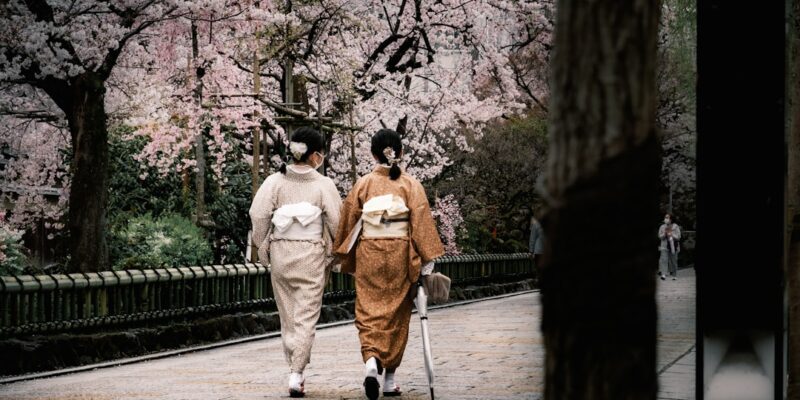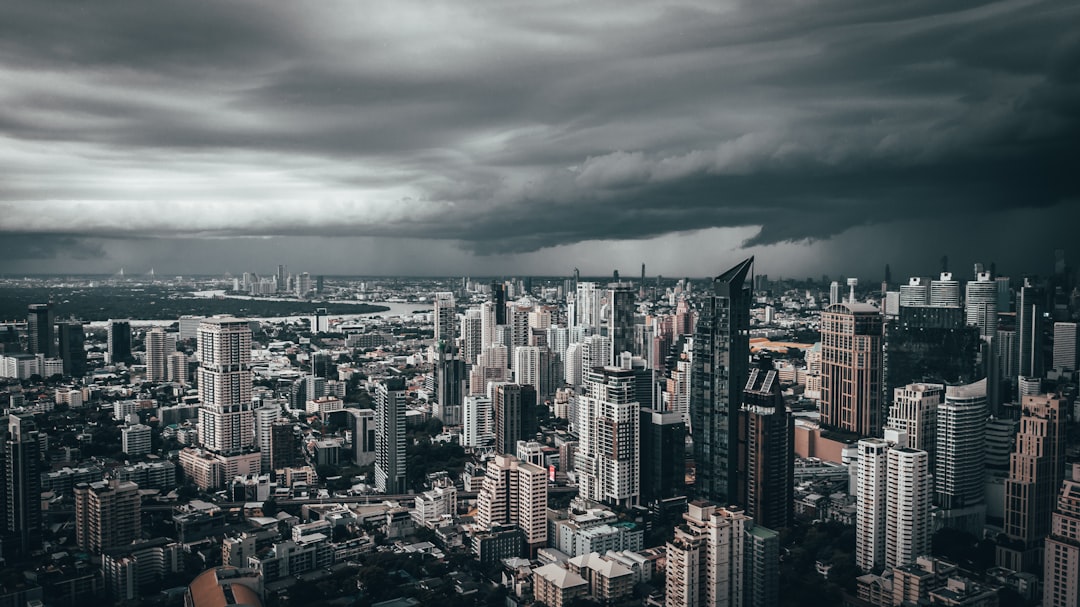
Kyoto’s Cherry Blossom Spectacle: Japan’s Springtime Delight
Cherry blossoms, known as sakura in Japanese, are one of the most iconic symbols of Japan. Every spring, these delicate pink flowers bloom across the country, transforming parks, streets, and mountainsides into a breathtaking sea of pink. The cherry blossom season is eagerly anticipated by locals and tourists alike, as it marks the arrival of spring and symbolizes renewal and the transient nature of life. In this blog post, we will explore the history and significance of cherry blossoms in Japan, the best time and places to view them in Kyoto, the different types of cherry blossom trees in Kyoto, the cultural activities and festivals during cherry blossom season, the best food and drinks to enjoy during this time, the importance of hanami (cherry blossom viewing) in Japanese culture, the symbolism and meaning behind cherry blossoms in Japanese folklore, the role of cherry blossoms in Japanese art and literature, the impact of climate change on cherry blossom season in Kyoto, and finally, the future of cherry blossom viewing in Kyoto and Japan.
Key Takeaways
- Cherry blossoms have been a significant part of Japanese culture for over a thousand years.
- The best time to view cherry blossoms in Kyoto is from late March to early April, and popular spots include Maruyama Park and Philosopher’s Path.
- Kyoto is home to several types of cherry blossom trees, including Somei Yoshino and Yamazakura.
- During cherry blossom season, cultural activities and festivals such as hanami parties and tea ceremonies take place throughout Kyoto.
- Traditional Japanese foods and drinks such as sakura mochi and sake are popular during cherry blossom season in Kyoto.
- Hanami, or cherry blossom viewing, is an important cultural tradition in Japan that brings people together to appreciate the beauty of nature.
- Cherry blossoms symbolize the fleeting nature of life and are often associated with themes of renewal and hope in Japanese folklore.
- Cherry blossoms have been a popular subject in Japanese art and literature for centuries, representing beauty, elegance, and transience.
- Climate change has had a significant impact on cherry blossom season in Kyoto, with earlier blooming times and shorter viewing periods.
- The future of cherry blossom viewing in Kyoto and Japan depends on efforts to mitigate the effects of climate change and preserve the natural beauty of these iconic trees.
The History and Significance of Cherry Blossoms in Japan
Cherry blossoms have a long history in Japan, dating back thousands of years. It is believed that they were first introduced to Japan from China during the Nara period (710-794). Since then, cherry blossoms have become deeply ingrained in Japanese culture and hold great significance. They are seen as a symbol of beauty, purity, and the transient nature of life. The short blooming period of cherry blossoms, which lasts only a few weeks, is seen as a metaphor for the fleeting nature of life and reminds people to appreciate the present moment.
Cherry blossoms have also played an important role in Japanese art and literature. They have been depicted in countless paintings, poems, and songs throughout history. One famous example is “The Tale of Genji,” a classic work of Japanese literature written by Murasaki Shikibu in the 11th century. In this epic novel, cherry blossoms are used as a metaphor for the beauty and impermanence of life. Cherry blossoms have also been a popular subject in ukiyo-e woodblock prints, which were widely produced during the Edo period (1603-1868). These prints often depicted scenes of cherry blossom viewing parties, known as hanami, and captured the festive atmosphere of the season.
The Best Time and Places to View Cherry Blossoms in Kyoto
Kyoto is one of the best places in Japan to view cherry blossoms. The city is home to numerous parks, temples, and gardens that are filled with cherry blossom trees. The peak cherry blossom season in Kyoto usually occurs in late March to early April, although the exact timing can vary depending on weather conditions. During this time, the city is transformed into a magical wonderland as cherry blossoms bloom in full force.
Some of the top locations for cherry blossom viewing in Kyoto include Maruyama Park, which is famous for its large weeping cherry tree; Philosopher’s Path, a scenic canal lined with hundreds of cherry trees; and Arashiyama Bamboo Grove, where visitors can enjoy the stunning combination of cherry blossoms and bamboo. Other popular spots include Kiyomizu-dera Temple, Nijo Castle, and the Imperial Palace Park.
To avoid crowds during cherry blossom season, it is recommended to visit popular spots early in the morning or late in the evening when there are fewer people. It is also a good idea to explore lesser-known areas of Kyoto that are off the beaten path but still offer beautiful cherry blossom views. Additionally, it is important to check the weather forecast and plan your visit accordingly, as rain or strong winds can cause the delicate cherry blossoms to fall prematurely.
The Different Types of Cherry Blossom Trees in Kyoto
| Type of Cherry Blossom Tree | Blooming Period | Color of Blossoms | Location in Kyoto |
|---|---|---|---|
| Somei Yoshino | Late March to Early April | Pale Pink | Maruyama Park, Philosopher’s Path, Nijo Castle |
| Yaezakura | Mid to Late April | Deep Pink | Heian Shrine, Arashiyama, Kyoto Botanical Garden |
| Shidarezakura | Mid to Late April | Pale Pink | Kiyomizu Temple, Hirano Shrine, Kyoto Imperial Palace |
| Ukon | Early to Mid April | Yellow | Daigoji Temple, Kitano Tenmangu Shrine |
| Kanzan | Mid to Late April | Deep Pink | Kyoto Imperial Palace, Kyoto Botanical Garden |
There are several different types of cherry blossom trees in Kyoto, each with its own unique characteristics and blooming patterns. Some of the most popular varieties for cherry blossom viewing in Kyoto include Somei Yoshino, Yamazakura, and Shidarezakura.
Somei Yoshino is the most common type of cherry blossom tree in Japan and is known for its pale pink flowers. It blooms early in the season and has a short blooming period, usually lasting only a week or two. Somei Yoshino cherry blossoms can be seen throughout Kyoto, including at popular spots such as Maruyama Park and Kiyomizu-dera Temple.
Yamazakura, or mountain cherry, is another popular variety in Kyoto. It has darker pink flowers and blooms slightly later than Somei Yoshino. Yamazakura cherry blossoms can be found in the mountains surrounding Kyoto, such as at Kurama-dera Temple and Mount Hiei.
Shidarezakura, or weeping cherry, is known for its cascading branches and graceful appearance. It blooms later in the season and has a longer blooming period compared to other varieties. Shidarezakura cherry blossoms can be seen at places like Arashiyama Bamboo Grove and Nijo Castle.
The Cultural Activities and Festivals During Cherry Blossom Season
Cherry blossom season is not just about admiring the beautiful flowers; it is also a time for cultural activities and festivals. One of the most popular customs during this time is hanami, which literally means “flower viewing.” Hanami involves gathering with friends, family, or colleagues under cherry blossom trees to have a picnic or enjoy a drink while appreciating the beauty of the flowers. Hanami parties can be found in parks and gardens throughout Kyoto during cherry blossom season.
In addition to hanami, there are also various events and festivals held in Kyoto during cherry blossom season. One of the most famous is the Miyako Odori, or “Cherry Blossom Dance,” which takes place at the Gion Kobu Kaburenjo Theater in the Gion district. This traditional dance performance features geisha and maiko (apprentice geisha) and is a must-see for visitors to Kyoto during cherry blossom season.
Other popular events include the Higashiyama Hanatoro, a night-time illumination event held in the Higashiyama district, and the To-ji Temple Cherry Blossom Festival, which features food stalls, performances, and illuminations. These events offer a unique opportunity to experience Japanese culture and traditions while surrounded by cherry blossoms.
The Best Food and Drinks to Enjoy During Cherry Blossom Season in Kyoto
No visit to Kyoto during cherry blossom season would be complete without trying some of the traditional Japanese foods and drinks associated with this time of year. One popular food is sakura mochi, a sweet rice cake filled with red bean paste and wrapped in a pickled cherry leaf. Sakura mochi is often enjoyed during hanami parties and is said to bring good luck.
Another popular food is hanami dango, which are skewered rice dumplings in three different colors: pink, white, and green. Hanami dango are often enjoyed as a snack during hanami parties and are a symbol of spring.
As for drinks, one of the most famous is sakura tea, which is made by infusing cherry blossoms in hot water. Sakura tea has a delicate floral flavor and is often served during hanami parties. Another popular drink is sakura sake, which is made by infusing cherry blossoms in rice wine. Sakura sake has a light pink color and a subtle cherry blossom aroma.
During cherry blossom season, many restaurants and cafes in Kyoto offer special menus featuring cherry blossom-themed dishes and drinks. Some popular recommendations include Kyo-ryori (traditional Kyoto cuisine) restaurants, where you can enjoy seasonal dishes made with local ingredients, and tea houses that serve matcha (green tea) and wagashi (traditional Japanese sweets) in a serene setting.
The Importance of Hanami (Cherry Blossom Viewing) in Japanese Culture
Hanami, or cherry blossom viewing, is an important cultural tradition in Japan. It has been practiced for centuries and holds great significance in Japanese society. Hanami is not just about admiring the beauty of the cherry blossoms; it is also a time for people to come together and celebrate the arrival of spring.
One of the key aspects of hanami is the sense of community it fosters. During cherry blossom season, parks and gardens are filled with people enjoying picnics, playing games, and simply relaxing under the cherry trees. Hanami parties are a way for friends, family, and colleagues to bond and create lasting memories.
Hanami also plays a role in Japanese aesthetics and appreciation of nature. The beauty of cherry blossoms is seen as a reflection of the transient nature of life and the impermanence of all things. This concept, known as mono no aware, is deeply ingrained in Japanese culture and is often associated with cherry blossoms.
In addition to its cultural significance, hanami also has historical roots. The practice of hanami can be traced back to the Heian period (794-1185), when aristocrats would gather under cherry trees to compose poetry and engage in other cultural activities. Over time, hanami became more accessible to the general public and spread throughout Japan.
The Symbolism and Meaning Behind Cherry Blossoms in Japanese Folklore
Cherry blossoms hold deep symbolism and meaning in Japanese folklore. They are often associated with themes of beauty, purity, and the transient nature of life. In Japanese mythology, cherry blossoms are said to be the flowers of the gods and are believed to bring good fortune and ward off evil spirits.
One popular myth is the story of Princess Konohana Sakuya, who is said to be the goddess of cherry blossoms. According to the legend, Princess Konohana Sakuya descended from the heavens and married a mortal man. She was put to a test by her husband’s family, who doubted her purity. To prove her innocence, she entered a burning house and emerged unscathed, holding a cherry blossom branch. This act of purity and resilience is said to be the origin of cherry blossoms.
Cherry blossoms also play a role in Japanese spirituality and religion. They are often associated with Buddhism and are seen as a symbol of enlightenment and the transient nature of existence. In Zen Buddhism, cherry blossoms are used as a metaphor for the impermanence of all things and the importance of living in the present moment.
The Role of Cherry Blossoms in Japanese Art and Literature
Cherry blossoms have long been a popular subject in Japanese art and literature. They have been depicted in paintings, poems, and songs for centuries and have become synonymous with Japanese aesthetics.
In Japanese art, cherry blossoms are often portrayed in ukiyo-e woodblock prints. These prints capture the beauty and fleeting nature of cherry blossoms and often depict scenes of hanami parties or landscapes filled with blooming cherry trees. One famous example is “The Great Wave off Kanagawa” by Katsushika Hokusai, which features a towering wave with Mount Fuji in the background and cherry blossoms in the foreground.
Cherry blossoms also feature prominently in Japanese poetry, particularly haiku. Haiku is a traditional form of Japanese poetry that consists of three lines with a 5-7-5 syllable pattern. Many haiku poems focus on nature and the changing seasons, and cherry blossoms are a popular subject. One famous haiku by Matsuo Basho reads:
An old silent pond…
A frog jumps into the pond—
Splash! Silence again.
This haiku captures the beauty and simplicity of nature, with the cherry blossoms serving as a backdrop to the scene.
The influence of cherry blossoms can also be seen in other forms of Japanese art and design, such as ceramics, textiles, and architecture. The delicate pink color of cherry blossoms is often used in traditional Japanese patterns and motifs, adding a touch of elegance and beauty to everyday objects.
The Impact of Climate Change on Cherry Blossom Season in Kyoto
Climate change is having a significant impact on cherry blossom season in Kyoto and throughout Japan. Rising temperatures and changing weather patterns are causing shifts in blooming patterns and peak season, making it more difficult to predict when and where cherry blossoms will bloom.
In recent years, cherry blossoms have been blooming earlier than usual in Kyoto. This is believed to be due to warmer temperatures in the spring months. As a result, the peak cherry blossom season has been shifting earlier, causing some concern among locals and tourists who plan their visits based on the traditional blooming period.
The changing climate also poses a threat to the longevity of cherry blossom trees. Warmer temperatures can cause the flowers to bloom too quickly and fall prematurely, reducing the amount of time people have to enjoy them. Additionally, extreme weather events such as typhoons or heavy rain can damage or destroy cherry blossom trees, further impacting their blooming patterns.
Efforts are being made to mitigate the effects of climate change on cherry blossoms in Kyoto. Local governments and organizations are monitoring weather patterns and collecting data on blooming times to better understand the impact of climate change. They are also implementing measures to protect cherry blossom trees from extreme weather events, such as installing windbreaks or reinforcing branches.
The Future of Cherry Blossom Viewing in Kyoto and Japan
The future of cherry blossom viewing in Kyoto and Japan is uncertain due to the impact of climate change. While efforts are being made to preserve and protect cherry blossom trees, there is no guarantee that they will continue to bloom as they have in the past.
However, there is hope that technology and innovation can enhance the cherry blossom viewing experience. Virtual reality (VR) and augmented reality (AR) technologies could allow people to experience cherry blossoms even if they are unable to visit Japan in person. These technologies could recreate the sights, sounds, and even scents of cherry blossoms, providing a lifelike experience for those who are unable to witness them firsthand.
Additionally, advancements in genetic engineering could potentially create new varieties of cherry blossom trees that are more resilient to climate change. Scientists are exploring ways to modify the genes of cherry blossom trees to make them more resistant to rising temperatures or extreme weather events. While this technology is still in its early stages, it holds promise for the future of cherry blossom viewing.
Cherry blossoms hold a special place in Japanese culture and are deeply cherished by the Japanese people. They symbolize beauty, purity, and the transient nature of life. The arrival of cherry blossoms in spring is eagerly anticipated each year, and hanami parties are a time for friends, family, and colleagues to come together and celebrate.
Kyoto is one of the best places in Japan to view cherry blossoms, with its numerous parks, temples, and historic streets lined with cherry trees. The city’s most famous cherry blossom spot is the Philosopher’s Path, a scenic canal lined with hundreds of cherry trees that bloom in a stunning display of pink and white petals. Another popular spot is Maruyama Park, where visitors can enjoy hanami (cherry blossom viewing) parties under the illuminated trees at night. Additionally, the iconic Kiyomizu-dera Temple offers breathtaking views of cherry blossoms from its wooden terrace, providing a unique and unforgettable experience for visitors.
FAQs
What is cherry blossom season in Kyoto, Japan?
Cherry blossom season in Kyoto, Japan is the time of year when the cherry trees bloom, usually in late March or early April.
Why is cherry blossom season in Kyoto, Japan so popular?
Cherry blossom season in Kyoto, Japan is popular because of the beauty of the cherry blossoms and the cultural significance they hold in Japan. It is also a time for celebration and festivals.
What are some popular spots to view cherry blossoms in Kyoto, Japan?
Some popular spots to view cherry blossoms in Kyoto, Japan include Maruyama Park, Philosopher’s Path, and the Kyoto Imperial Palace.
How long does cherry blossom season in Kyoto, Japan last?
Cherry blossom season in Kyoto, Japan typically lasts for about one to two weeks, depending on the weather.
What is the best time of day to view cherry blossoms in Kyoto, Japan?
The best time of day to view cherry blossoms in Kyoto, Japan is during the daytime when the sun is shining. However, some spots may also offer nighttime illuminations of the cherry blossoms.
What should I wear when viewing cherry blossoms in Kyoto, Japan?
It is recommended to wear comfortable clothing and shoes when viewing cherry blossoms in Kyoto, Japan. It is also a good idea to bring a jacket or sweater as the weather can be unpredictable.
Are there any customs or traditions associated with cherry blossom season in Kyoto, Japan?
Yes, there are customs and traditions associated with cherry blossom season in Kyoto, Japan. One tradition is called hanami, which is the act of having a picnic under the cherry blossoms. It is also customary to appreciate the beauty of the cherry blossoms and to take part in festivals and celebrations.



















Can you be more specific about the content of your article? After reading it, I still have some doubts. Hope you can help me.
Thank you for your sharing. I am worried that I lack creative ideas. It is your article that makes me full of hope. Thank you. But, I have a question, can you help me?